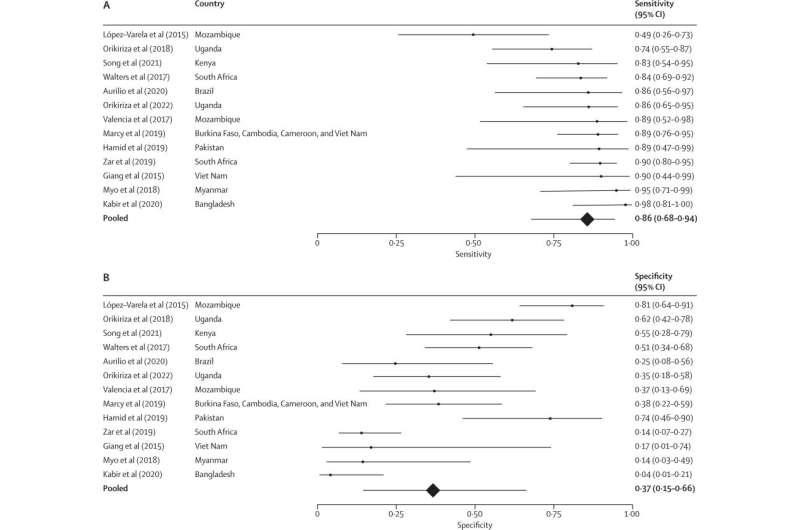This article has been reviewed according to Science X's editorial process and policies. Editors have highlighted the following attributes while ensuring the content's credibility:
fact-checked
trusted source
proofread
New algorithms could improve pediatric tuberculosis diagnosis

Tuberculosis stands as one of the leading causes of death among young people across the world. Modeling studies suggest that in over 96% of the deadly cases involving children younger than 15 years old, the infected child did not receive treatment.
Two new evidence-based algorithms for diagnosing pediatric tuberculosis could help reverse this trend.
Yale School of Public Health scientists led the team that developed algorithm-based scoring systems that health care workers can use to inform their decisions when diagnosing the disease, which is often difficult to identify in under-resourced clinics. The Yale team, in collaboration with a global network of scientists, looked at data from more than 4,000 children with TB from across the world and, through statistical analysis, developed what they say are the most robust algorithms yet for pediatric tuberculosis.
As a result of the team's analysis, the World Health Organization now recommends the use of algorithms in its latest consolidated guidelines for treating the disease. The WHO is also encouraging the use of the Yale-led research team's algorithms.
"It's a lot of pressure for these health care workers to consider vague symptoms and make a diagnosis for TB, which might partly explain why we have gaps in treating TB in young children," said Kenneth Gunasekera, a Yale M.D.-Ph.D. student who was first author on the study. "Our work was motivated by this issue. We wanted to support health care workers operating in resource-limited settings to make treatment decisions for TB that are evidence-based."
The findings appear in The Lancet Child & Adolescent Health.
Algorithms are not new to pediatric tuberculosis. Other scientists have created similar algorithms to enhance disease diagnosis, but Gunasekera explained that those algorithms have largely relied on expert opinion, rather than a rigorous interpretation of data. Also, some of the algorithms that have been based on evidence were built using data from a relatively small sample size, which can limit their generalizability, Gunasekera said. Gunasekera's team combined data from 4,718 children from 13 studies and 12 countries, with the help of recommendations from a group of WHO-identified experts, in an effort to develop sturdier scoring systems.

The researchers built two algorithms depending on the ability of health care workers to obtain chest X-rays for their patients. In both algorithms, patients receive a set number of points for their presenting symptoms and other details, which workers then add up to receive the recommendation. If the score is above 10, on average, 85% of those children with TB will be diagnosed correctly. (Patients can also score above a 10 if they were known to be exposed to tuberculosis notwithstanding other symptoms.)
"Now we have a tool that is evidence-based and pragmatic in that it's easy for a health care worker to implement this score," Gunasekera said. The team hopes the new tool will result in more children receiving timely treatment for TB.
But, the researchers warn, there are some limitations to their scoring systems. Most importantly, the team could not formally test the algorithms before their paper published. However, studies will soon be underway to evaluate the algorithms' real-world ability to identify tuberculosis. And even though drawing from multiple studies can help improve statistical analysis and create more robust data sets, varying inclusion criteria, and study definitions could lead to slightly skewed data. Finally, since tuberculosis is already difficult to diagnose, some incorrect conclusions "might occur," the authors wrote in their study. More research into pediatric tuberculosis would undoubtedly help refine the new algorithms, as would additional data and better diagnostic tools.
Still, Gunasekera explained, the fact that the WHO conditionally recommended the use of algorithms in assisting with pediatric tuberculosis diagnosis and encouraged the Yale-led team's new algorithms for use in the field stands as a powerful encouragement for future research.
"I'm really looking forward to seeing the results of the prospective evaluation of these algorithms, when others are actually going to use them in a study setting to aid in treatment decision-making for children being investigated for TB," he said. "We built the algorithms based on evidence, but it will be exciting to see how well they will actually perform."
The research carries a personal resonance for Gunasekera, who is in the last year of his M.D.-Ph.D. program at Yale and hopes to work in pediatrics after graduation. The project emerged from valuable mentorship with leaders at YSPH and beyond, he said.
"Through this work, I got to work closely with some of the leaders in the pediatric TB field, and it was honestly such a delight to be working with so many of the people whose papers I had been reading," he said. "Now, the people whom I had idolized were people I was working with as colleagues. It was really an amazing opportunity and experience for me while trying to tackle this important problem in childhood TB and global public health."
More information: Kenneth S Gunasekera et al, Development of treatment-decision algorithms for children evaluated for pulmonary tuberculosis: an individual participant data meta-analysis, The Lancet Child & Adolescent Health (2023). DOI: 10.1016/S2352-4642(23)00004-4


















